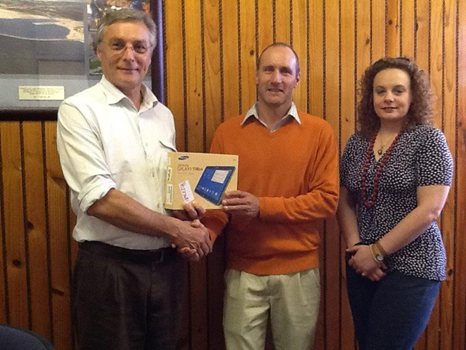Congratulations to Dr Gletwyn Rubidge (Chemistry) who won the E-MIS sponsored Samsung Tablet. Dr Rubidge's Science to Schools Outreach project benefits high school learners in the Port Elizabeth area. As the project name indicates, Dr Rubidge and his team take science to schools, where they perform memorable and striking syllabus-based experiments that teachers may not be able to perform themselves, due to a lack of resources, facilities or teacher experience. The project also includes teacher training, the provision of science kits to schools, support via electronic media and rendering assistance to learners with science projects.

Prof George de Lange and Dr Belinda du Plooy with the winner of the Samsung Tablet, Dr Gletwyn Rubidge (Chemistry, middle).
What is the Engagement Management Information System (E-MIS)?
The Engagement MIS system is a central system that allows staff members to capture all Engagement Activities and Projects for the purpose of monitoring and evaluation of engagement projects, as well as providing a consolidated database where all external collaboration and projects can be recorded and reported on.
This system serves as a central repository for Engagement documentation in an access restricted environment.
The vision is for staff in all areas of engagement to be able to capture their own projects, external and internal stakeholders onto a common system from where a history can be kept of past and current engagement by the various departments at the university.
The Engagement MIS system focuses on collecting information as pertaining to the various categories of engagement at the university namely,
(1) Community Interaction, Service & Outreach,
(2) Engagement through Professional/Discipline based Provision,
(3) Teaching & Learning, and
(4) Research & Scholarships.
Benefits of the system for staff members who are actively involved with some form of Engagement at Nelson Mandela University
-
Their Engagement projects and activities will be noticed and acknowledged via Management systems and structures (this is a space to showcase what they are doing)
-
They will create an accessible central repository for their project information by means of which they can track, review, report on and plan their projects
-
They will be able to use the E-MIS summative reports as part of their personal portfolio for promotions, assessments, funding and award applications
Accessing the system
A link to the Engagement MIS site can be found on the Staff Portal under “Online Forms ->Tools&Services->Engagement & Collaboration->Engagement MIS”.
The direct link to the site is https://depts.mandela.ac.za/Engagement/SitePages/Home.aspx, accessible to all staff.
Academics and other staff related to engagement with external parties can capture and update their specific project/activity information here.
Access is governed through the Microsoft Active Directory (AD) of the university ensuring that only staff members can see their own information, and staff to whom they have decided to grant access.
A list of all registered Engagement projects can be accessed via the E-MIS (share point site) by following steps 1-5 below, then double clicking on “Engagement Number of Projects” on the right side of the share point site under Reports. Choose ‘all’ for both the Faculty and Department fields and then click on ‘View Report’.
How to update existing Engagement project information or add a new project
Use the above link or the following route to access the E-MIS share point site:
-
Staff Portal
-
Online Forms
-
Tools and Services
-
Engagement & Collaboration
-
Engagement MIS (this is the E-MIS share point site)
-
Click here to add MIS document (work from here to add a new project that has not yet been uploaded onto the system)
-
To see which projects you already have access to: Close (red X in left corner of screen under Edit), a list of your own projects should appear on your screen
There is a user-friendly and easily accessible electronic form that you need to complete when you click on a specific project (start with the “Project Definition” page and just follow the ‘Next’ prompts up to ‘Submit’ on the last page).
Complete all fields in detail and on the final page ‘submit’ for your information to be saved. By clicking on “ECF” in the left corner of the page you will be able to view the university's Engagement Conceptual Framework.
If you wish to delegate these management/administration duties to someone else in your department/project,
Do so by granting them access under the “Team Members” section, using the “Grant Staff Permission” button:
Use the browse button (the little open book) to search for the person via the university's e-mail address book, then click on the “Add User to Permission List” button, then click on “Grant Access”.
Note that your project must have been created on the system before you can grant permissions, so if you are adding a new project, run through the electronic form to create a shell document by adding basic information in required fields first, then under the “Team Members” section grant permission to whomever will be updating the page for you.